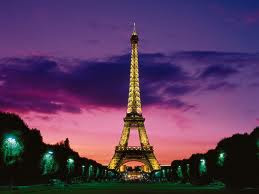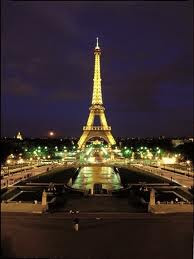The Eiffel Tower is a puddle iron lattice tower located on the Champ de Mars in Paris. Built in 1889, it has become both a global icon of France and one of the most recognizable structures in the world. The tower is the tallest building in Paris and the most-visited paid monument in the world; millions of people ascend it every year. Named for its designer, engineer Gustave Eiffel, the tower was built as the entrance arch to the 1889 World's Fair.
The tower stands 324 metres (1,063 ft) tall, about the same height as an 81-storey building. Upon its completion, it surpassed the Washington Monument to assume the title of tallest man-made structure in the world, a title it held for 41 years, until the Chrysler Building in New York City was built in 1930; however, due to the addition in 1957 of the antenna, the tower is now taller than the Chrysler Building. Not including broadcast antennas, it is the second-tallest structure in France after the 2004 Millau Viaduct. The tower has become the most prominent symbol of both Paris and France, often in the establishing shot of films set in the city.
History
The structure was built between 1887 and 1889 as the entrance arch for the Exposition Universelle, a World's Fair marking the centennial celebration of the French Revolution. Three hundred workers joined together 18,038 pieces of puddled iron using two and a half million rivets, in a structural design by Maurice Koechlin. Eiffel was assisted in the design by engineers Émile Nouguier and Maurice Koechlin and architect Stephen Sauvestre. The risk of accident was great as, unlike modern skyscrapers, the tower is an open frame without any intermediate floors except the two platforms. However, because Eiffel took safety precautions, including the use of movable stagings, guard-rails and screens, only one man died. The tower was inaugurated on 31 March 1889, and opened on 6 May.
The tower was much criticised by the public when it was built, with many calling it an eyesore. Newspapers of the day were filled with angry letters from the arts community of Paris. One is quoted extensively in William Watson's US Government Printing Office publication of 1892 Paris Universal Exposition: Civil Engineering, Public Works, and Architecture: "And during twenty years we shall see, stretching over the entire city, still thrilling with the genius of so many centuries, we shall see stretching out like a black blot the odious shadow of the odious column built up of riveted iron plates." Signers of this letter included Jean-Louis-Ernest Meissonier, Charles Gounod, Charles Garnier, Jean-Léon Gérôme, William-Adolphe Bouguereau, and Alexandre Dumas. One of the great Hollywood movie clichés is that the view from a Parisian window always includes the tower. In reality, since zoning restrictions limit the height of most buildings in Paris to 7 stories, only a very few of the taller buildings have a clear view of the tower.
Design of the tower
Material
The pig iron structure of the Eiffel Tower weighs 7,300 tonnes while the entire structure, including non-metal components, is approximately 10,000 tonnes. As a demonstration of the economy of design, if the 7,300 tonnes of the metal structure were melted down it would fill the 125 metre square base to a depth of only 6 cm (2.36 in), assuming the density of the metal to be 7.8 tonnes per cubic metre. Depending on the ambient temperature, the top of the tower may shift away from the sun by up to 18 cm (7.1 in) because of thermal expansion of the metal on the side facing the sun.
Wind considerations
Researchers have found that Eiffel used empirical and graphical methods accounting for the effects of wind rather than a specific mathematical formula. Careful examination of the tower shows a basically exponential shape; actually two different exponentials, the lower section overdesigned to ensure resistance to wind forces. Several mathematical explanations have been proposed over the years for the success of the design; the most recent is described as a nonlinear integral equation based on counterbalancing the wind pressure on any point on the tower with the tension between the construction elements at that point. As a demonstration of the tower's effectiveness in wind resistance, it sways only 6–7 cm (2–3 in) in the wind.
Maintenance
Maintenance of the tower includes applying 50 to 60 tonnes of paint every seven years to protect it from rust.
Aesthetic considerations
In order to maintain a uniform appearance to an observer on the ground, three separate colours of paint are used on the tower, with the darkest on the bottom and the lightest at the top. On occasion the colour of the paint is changed; the tower is currently painted a shade of brownish-grey. On the first floor there are interactive consoles hosting a poll for the colour to use for a future session of painting.
Popularity
More than 200,000,000 people have visited the tower since its construction in 1889, including 6,719,200 in 2006. The tower is the most-visited paid monument in the world.






No comments:
Post a Comment